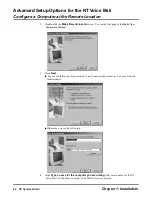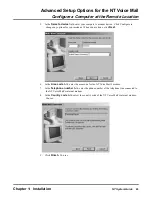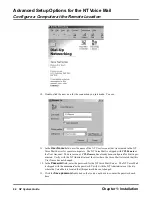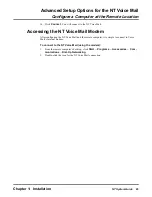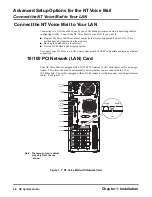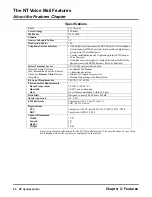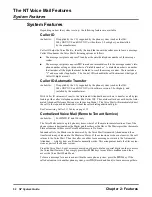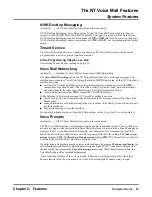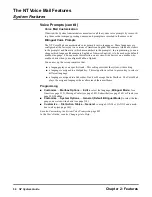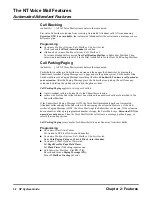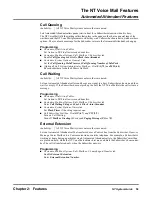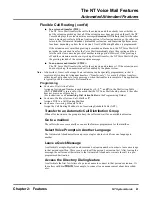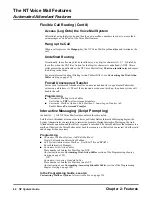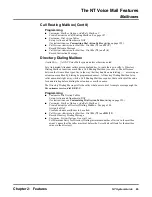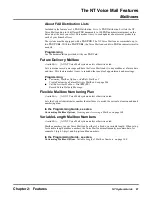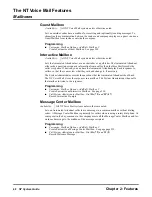
The NT Voice Mail Features
System Features
Chapter 2: Features
NT System Guide
55
NVM-Desktop Messaging
NVM-Desktop Messaging is an add-on option for the NT Voice Mail system that provides on-
screen Voice Mail,
FAX
Mail, and E-Mail capability. To support 64 or fewer client workstations,
NVM-Desktop Messaging requires a minimum of 8
MB
of
RAM
. But for 65 or more workstations,
NVM-Desktop Messaging requires a minimum of 12
MB
of
RAM
. See the documentation for this
option.
Tenant Service
Up to four different businesses or tenants can share one NT Voice Mail system, which you can
program either to allow or prevent intertenant calling.
In the Programming Chapter, see also:
Customizing Tenant Options starting on page 335.
Voice Mail Networking
The Voice Mail Networking option lets NT Voice Mail mailbox users exchange messages with
mailbox users at another Voice Mail System that allows
AMIS
Networking, so that NT Voice Mail
mailbox users can:
Q
call their NT Voice Mail mailboxes and record a message for someone at a remote
AMIS
-
compatible Voice Mail System. The Voice Mail collects all the recorded “network messages”
and sends them to the other Voice Mail systems at the pre-programmed time(s).
Q
receive messages from other
AMIS
-compatible Voice Mail systems.
While listening to a Network message, NT Voice Mail mailbox users can:
Q
record a reply, which will automatically be delivered to the message sender at the other Voice
Mail System.
Q
make an immediate call to the message sender at the other Voice Mail System without first exit-
ing their mailboxes.
Q
Forward the message to another mailbox.
(For detailed information about Voice Mail Networking, see the Voice Mail Networking Guide.)
Voice Prompts
The NT Voice Mail provides voice prompts to guide people in using the system. The recorded voice
prompts are step-by-step instructions telling callers what codes to press on their Touch Tone phone
to access the NT Voice Mail features. Generally, the codes are easy to remember, because they
match the first letter(s) of the feature name. These prompts illustrate the coding: To
L
isten to your
messages, press
L (5)
. To
R
ecord and
S
end a message, press
R S
(7 7). The caller does not have
to listen to the entire voice prompt before dialing a code.
If a caller forgets what code to press or presses a code and hears the prompt, That is an invalid entry, the
caller should just wait a few seconds without pressing any digits. The NT Voice Mail will repeat the
choices or play the voice prompt, For a help message, press zero. When the caller presses zero, the
Voice Mail will provide a recorded help message.
A user can turn off some of the voice prompts, if desired. Users frequently do this when they
become familiar with the system and don’t want to be interrupted by unnecessary prompts.
Availability:
All NT Voice Mail systems unless otherwise noted.
Availability:
Intended for Voice Mail systems using AMIS Networking
Availability:
All NT Voice Mail systems unless otherwise noted.
Summary of Contents for NVM-NT
Page 28: ...Table of Contents Chapter 5 Maintenance xxvi NT System Guide ...
Page 130: ...Installing SMDI 102 NT System Guide Chapter 3 Programming ...
Page 146: ...Customizing Caller I D Tables General Tab 118 NT System Guide Chapter 3 Programming ...
Page 156: ...Customizing Callout Options Optional Tab 128 NT System Guide Chapter 3 Programming ...
Page 182: ...Customizing Distribution Lists General Tab 154 NT System Guide Chapter 3 Programming ...
Page 338: ...Customizing Port Options General Tab 310 NT System Guide Chapter 3 Programming ...
Page 358: ...Customizing System Options Timers Tab 330 NT System Guide Chapter 3 Programming ...
Page 362: ...Customizing System Options Timers Tab 334 NT System Guide Chapter 3 Programming ...
Page 367: ...Customizing Tenant Options General Tab Chapter 3 Programming NT System Guide 339 ...
Page 396: ...Viewing and Printing Reports System Options Report 368 NT System Guide Chapter 3 Programming ...
Page 400: ...Performing a Local Backup Backup Dialog Box 372 NT System Guide Chapter 3 Programming ...
Page 440: ...Using Port Activities 412 NT System Guide Chapter 3 Programming ...
Page 454: ...Using Message Status Message Status Dialog Box 426 NT System Guide Chapter 3 Programming ...


